08.31.10
Posted in Tropical Weather, Weather News at 9:47 pm by Rebekah
This week’s post in the global weather and climate series features Cape Hatteras, North Carolina (click for a Yahoo! maps link).
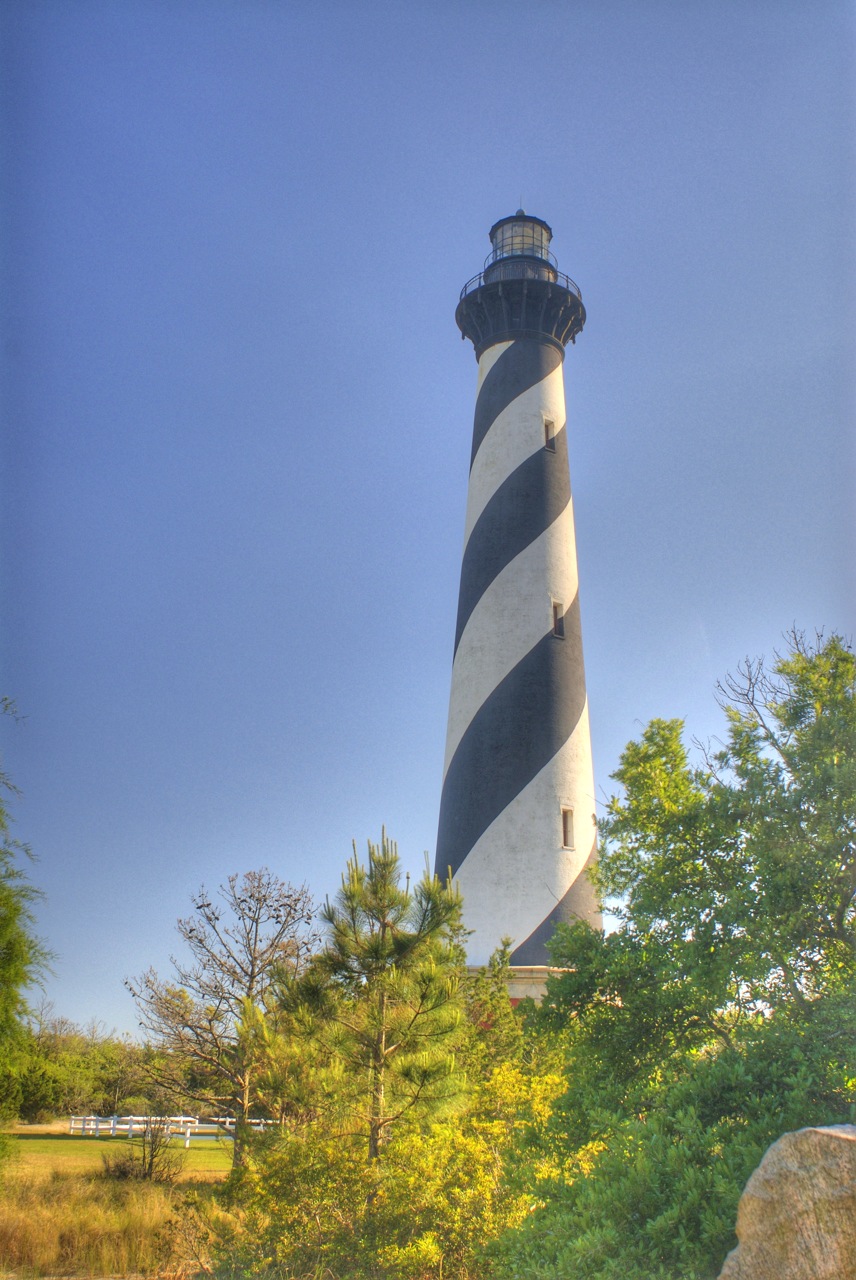
Cape Hatteras Lighthouse, Hatteras Island, North Carolina. Courtesy of Wikipedia.
Cape Hatteras is the point that just about sticks out the farthest along the North Carolina coast. On Hatteras Island in the Outer Banks of North Carolina, Cape Hatteras is most famous for its 208-ft-tall lighthouse, built in 1870. Cape Hatteras is also sometimes known as the “Graveyard of the Atlantic”, as so many ships have been lost there. The nearest town to the lighthouse is Buxton, an unincorporated community of nearly 1,500 people.
The Outer Banks is a 200-mile-long barrier island chain off the North Carolina coast. The islands are very narrow but separate Currituck Sound, Albemarle Sound, and Pamlico Sound from the Atlantic Ocean. The Wright brothers’ first flight took place from the Outer Banks, at Kill Devil Hills near Kitty Hawk, on the northern side of the island chain. Ocracoke Island, just southeast of Hatteras Island, was the home of the famed pirate Blackbeard (as well as the location of his death). The islands are highly prone to hurricanes; in September 2003, Hurricane Isabel’s storm surge washed out part of Hatteras Island.
A few more facts about Cape Hatteras (average weather data from Climate Zone, records from NWS):
- Time zone: Eastern Standard Time (UTC-5) or Eastern Daylight Time (UTC-4)
- Elevation: at sea level
- Climate zone: Temperate
- Average high temperature: 69 °F (21 °C)
- Average low temperature: 55 °F (13 °C)
- Record high temperature: 96 °F (36 °C)
- Record low temperature: 6 °F (-14 °C)
- Average annual precipitation: 56.1 inches (1,425 mm)
- Average annual snowfall: 1.9 inches (48 mm)
Current weather: In case you hadn’t guessed, I picked Cape Hatteras this week because Hurricane Earl is about to deal a glancing blow to the Outer Banks Thursday night/Friday morning. The last time I picked a North American City, Hurricane Alex was about to make landfall just south of Brownsville.
Earl is currently a Category 4 hurricane, moving northwest at 14 mph, with estimated maximum sustained wind speeds of 135 mph and a minimum central pressure of 940 mb. Here’s the latest National Hurricane Center forecast track for Earl (click to enlarge):
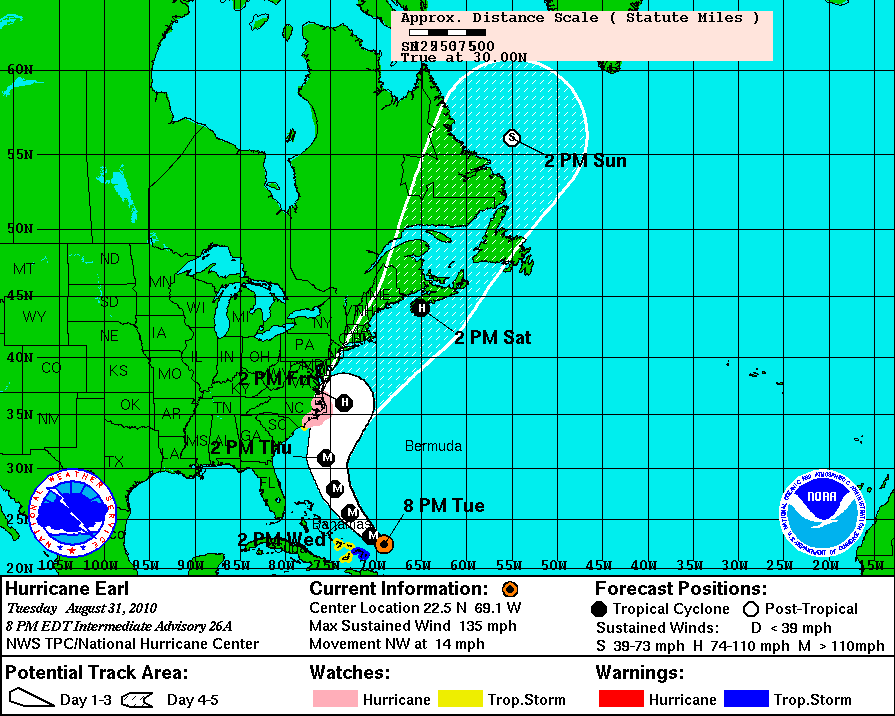
A hurricane watch was issued today for the Outer Banks, meaning hurricane conditions are possible and tropical storm conditions are expected to begin within 48 hours. Specific hazards mentioned in the watch include storm surges of 3 to 4 feet at Ocracoke Island and 1 to 2 feet elsewhere, hurricane-force winds (greater than 74 mph), and a high chance for rip currents as breaking waves may reach 15 feet. North Carolina officials announced tonight that an estimated 5,000 tourists have been ordered to evacuate Ocracoke Island (the only way to leave is by ferry), though year-round residents may choose to stay (estimated 800 residents).
Effects from the hurricane are anticipated to begin sometime Thursday afternoon.
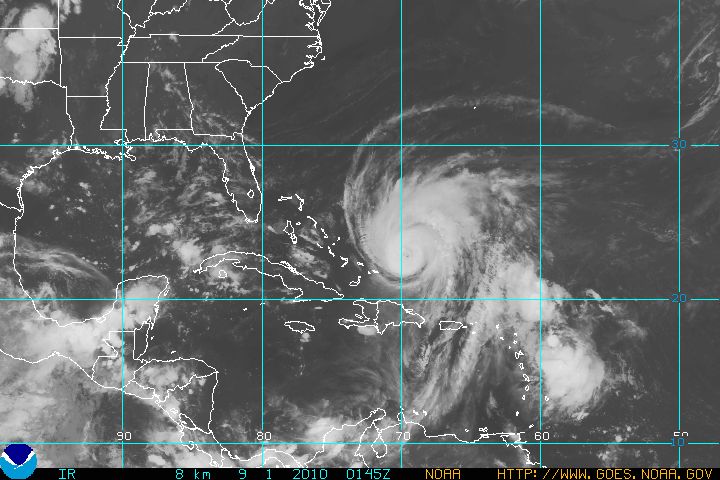
Hurricane Earl approaches the U.S. GOES infrared satellite image courtesy of NOAA. Click to enlarge.
For weather maps and information on current and forecast Cape Hatteras weather, see the Newport / Morehead City National Weather Service site. For the latest hurricane intensity and track information, as well as hurricane satellite images, see the National Hurricane Center.
For more information on Cape Hatteras, here’s a link to Wikipedia. For information on the Outer Banks, here’s another link to Wikipedia.
Next Tuesday I plan to take a look at the climate and weather in another part of the globe. As always, if you have any comments or suggestions for future cities, please leave a comment on this post!
Permalink
08.30.10
Posted in Non-US Weather, Severe Weather Nowcast, Tropical Weather, Weather News at 8:23 pm by Rebekah
There’s so much going on today weatherwise, it would be difficult to discuss it all, or even to just pick one topic. So tonight I’ll just stick with showing a few maps and noting a few highlights of each.
First up: tropical cyclones in the Atlantic.
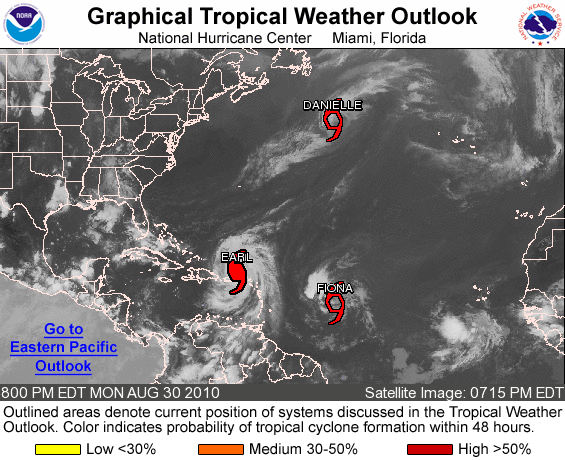
Figure from the National Hurricane Center.
The big story today is Earl, now a Category 4 hurricane with estimated sustained winds of 135 mph and a central minimum pressure of 938 mb, the lowest pressure in the Atlantic Basin since Hurricane Ike in 2008 (935 mb). Earl could become a borderline Category 5 hurricane tomorrow, when the cyclone is expected to peak at 150 mph (Category 5 has winds of over 155 mph).
Earl has brought heavy rain and strong winds to the Leeward Islands and Puerto Rico today, but is starting to move west-northwest away from Puerto Rico. Earl’s eye is expected to remain offshore, but some of the outer bands could affect the New England Coast by the end of the week.
Tropical Storm Fiona formed this evening, but is expected to remain weak. Danielle is now a tropical storm as well, moving well off into the north central Atlantic.
Second: tropical cyclones in the western Pacific.
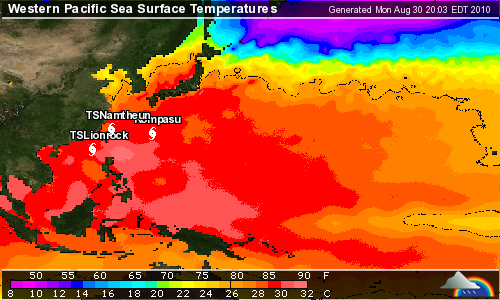
Figure from Weather Underground.
The western Pacific has been surprisingly quiet so far this year, but there are currently three tropical cyclones in this ocean basin as well. Typhoon Kompasu, with maximum sustained winds of 105 mph, is currently a Category 2 on the Saffir-Simpson scale and is forecast to become a Category 3 as it enters the East China Sea tomorrow. This typhoon is expected to hit the western North/South Korea border as a Category 2 on Thursday.
Tropical Storm Lionrock, with maximum sustained winds of 65 mph, is forecast to become a Category 1 tomorrow and make landfall as a tropical storm in southeast China (just west of Taiwan) on Thursday.
Tropical Storm Namtheun, with maximum sustained winds of 45 mph, is moving southwest and is expected to dissipate between Taiwan and China by Thursday, after running into Lionrock.
Third: severe thunderstorms in the Northern Plains.

Figure from the Storm Prediction Center.
A trough in the western United States is providing a chance for severe weather today and tonight in the Northern Plains. There is currently a line of thunderstorms from the Nebraska/South Dakota border up into Canada. None of these storms are particularly strong at the moment, but there were tornado warnings out earlier this evening in South Dakota.
Fourth: rain and cooler weather in Oklahoma.
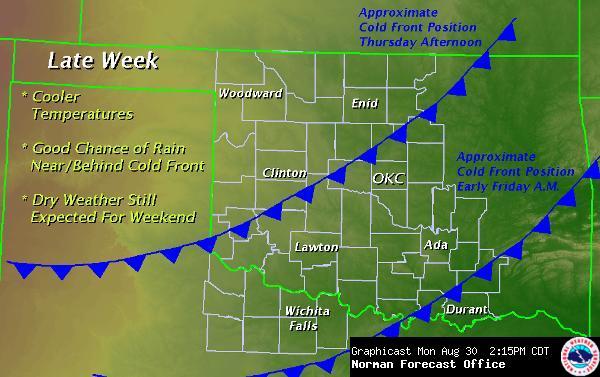
Figure from the National Weather Service in Norman.
We finally have showers and thunderstorms back in the forecast for this week! We are also expecting another cold front Thursday night, cooling down the temperatures a bit again for the weekend.
Autumn is on its way!
For up-to-date weather and website/blog updates, follow Green Sky Chaser on Twitter.
Permalink
08.27.10
Posted in Tropical Weather, Weather News at 9:09 pm by Rebekah
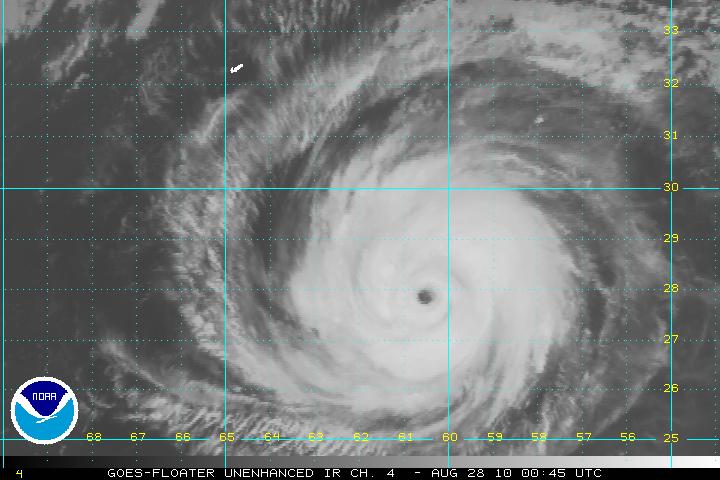
Hurricane Danielle reached Category 4 status today, with estimated sustained winds of 135 mph and a minimum central pressure of 942 mb. Danielle is expected to begin weakening within the next 12 hours or so, as she moves just east of Bermuda (see the infrared satellite image above, from NOAA NESDIS).
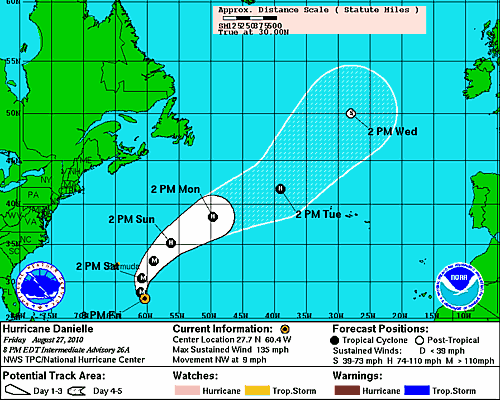
Tropical Storm Earl is still expected to become a hurricane soon, and a major hurricane (Category 3 or above) within 5 days.
Another area of interest is just southwest of the Cape Verde Islands again, as the National Hurricane Center has an 80% chance for a tropical depression to form there within the next 48 hours.
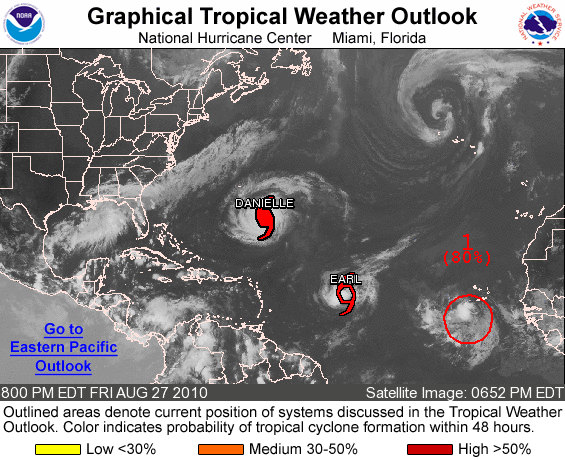
Permalink
08.26.10
Posted in Tropical Weather, Weather News at 4:30 pm by Rebekah
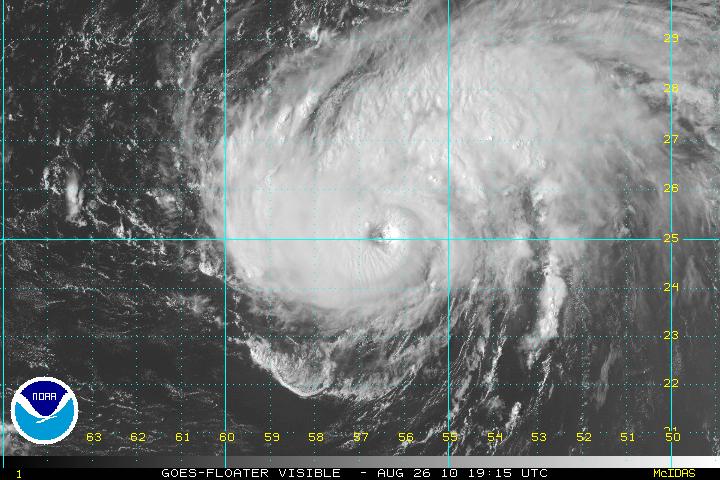
Category 2 Hurricane Danielle, from the NHC.
Yesterday we took a brief look at some of the factors behind tropical cyclone development. Those same factors come into play for tropical cyclone strengthening, particularly the warm water and lack of wind shear.
But once it’s formed, how does a tropical storm or hurricane move?
When tropical cyclones are small and still near the equator, they are at first steered by low-level easterly winds. Once tropical cyclones become stronger and move farther north (or south, if in the southern hemisphere), they are steered by upper-level troughs and ridges.
For example, all else being equal, if there is a trough over the eastern United States, an approaching hurricane will get steered back out to sea by southwesterly upper-level winds on the eastern side of the trough (the hurricane would also “want” to get closer to the falling pressure on the downwind side of the trough).
If there is a ridge over the eastern U.S., all else being equal, the hurricane may want to go south of the ridge and continue towards the coast. Also, if there is a high pressure system downwind of the ridge, the easterly winds on the southern side of the high would also push the storm westward.
Currently, a ridge is moving into the central and eastern U.S….but Danielle and Earl are forecast to stay out at sea. As a trough exits the U.S., Danielle will be pushed up towards the northeast. Also, in this case, the storms formed so far east they began to get pulled clockwise around the semi-permanent high pressure system over the eastern Atlantic (known as the Azores or Bermuda High).
At present, Danielle is a strong Category 2 hurricane with sustained winds of 110 mph and Earl is a strengthening tropical storm. Both cyclones are in areas of warm water and low vertical wind shear, so should continue to strengthen. Danielle should finally become a Category 3 hurricane by tomorrow night, while Earl is also forecast to become a Category 3 hurricane by Tuesday afternoon, at which point the storm may have some effect on the Leeward Islands before recurving back north and east.
In the eastern Pacific, Frank is a Category 1 hurricane with winds of 90 mph, but is forecast to weaken to a tropical depression by Monday, as the cyclone encounters colder waters off the coast of Mexico.
Models are showing that the next Atlantic tropical cyclone may form within a few days. The next name on the list is Fiona, replacing Frances, which was retired following the 2004 hurricane season.
Permalink
08.25.10
Posted in Tropical Weather, Weather News at 7:41 pm by Rebekah
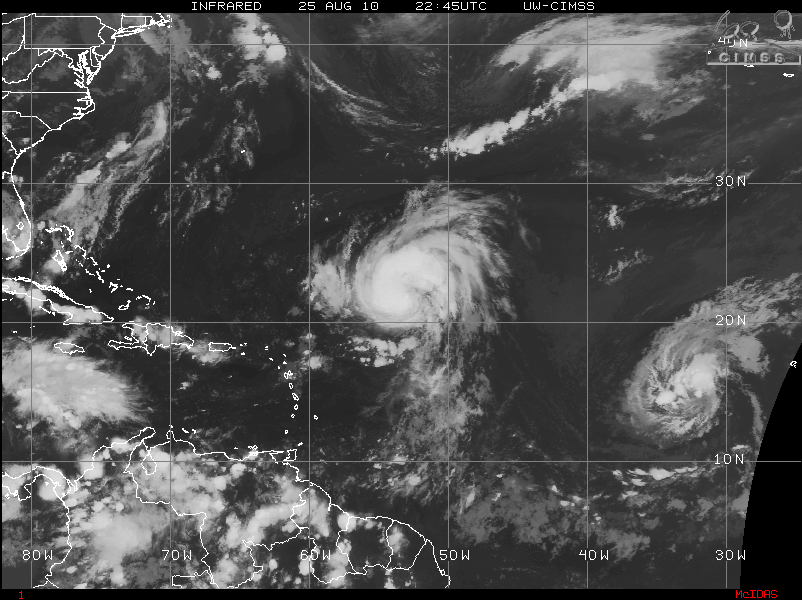
Infrared satellite image of Hurricane Danielle and Tropical Storm Earl. Courtesy of CIMSS. Click to enlarge.
Tropical cyclones are large low pressure systems that form in the tropics and obtain their energy from warm ocean waters, as opposed to extratropical cyclones which form over the mid-latitudes and obtain their energy from cold and warm fronts.
To form, tropical cyclones require:
- warm water (at least 80 °F / 27 °C)
- moist air
- instability
- lift
- a lack of wind shear
- some distance from the equator
Tropical cyclones begin with some sort of disturbance near the surface, usually in the form of a tropical/easterly wave, an old frontal boundary, the inter-tropical convergence zone (ITCZ), or the remnants of a previous tropical cyclone.
A tropical (or easterly) wave is a small, low-level, trough of low pressure located in the tropics. Convergence takes place upstream of a trough, while divergence takes place downstream of a trough. Since the trough is in the lower levels of the atmosphere, that upstream convergence occurs near the surface and is where rising air and clouds can be found. Tropical waves are the most common disturbance from which tropical cyclones form.
The ITCZ is a band of converging and rising air near the equator, as a result of northeast winds north of the equator meeting southeast winds south of the equator.
A tropical disturbance must be at least 5 or 10° away from the equator before cyclogenesis can occur. Supercell thunderstorms and tornadoes get their rotation from strong wind shear, while tropical cyclones get their rotation from the Coriolis force. The Coriolis force is an apparent force that is caused by the rotation of the earth, and acts to deflect objects to the right in the northern hemisphere and to the left in the southern hemisphere. You might have heard of this force with relation to the direction water drains down a bathtub. However, this force only takes effect on much larger scales, such as on the scale of a tropical cyclone. The Coriolis force is near zero at the equator and increases poleward, so tropical cyclones cannot form too close to the equator or they will not be able to rotate.

Get Fuzzy comic (click to enlarge).
Wind shear is a change of wind speed and/or direction over some distance. Vertical wind shear is a change of wind speed and/or direction (usually we talk about both) over height. As I mentioned above, tropical cyclones do not require wind shear to rotate, unlike tornadoes. In fact, if there is too much wind shear, it will rip a tropical cyclone apart and prevent it from further rotation and organization. A tropical disturbance must remain relatively undisturbed (pardon the pun) for some time before it can develop into a tropical depression (and eventually a tropical storm or hurricane). Weak winds throughout the atmosphere are the best for tropical cyclones.
Once a disturbance is in place over warm, moist waters, in an area lacking wind shear and at least 5 or 10° away from the equator, tropical cyclogenesis may occur.
———————————————-
Currently, Danielle is a Category 1 hurricane in the central Atlantic, starting to move northwestward towards Bermuda. Danielle may become a Category 2 hurricane again by Friday afternoon.
Earl is now the 5th named storm of the Atlantic hurricane season, forming this afternoon in the east Atlantic. Earl will move westward for a while, staying south of Danielle’s track and possibly becoming a hurricane by Friday afternoon.
Frank is a Category 1 hurricane just west of Mexico, but is expected to weaken to a tropical storm by Saturday morning, when he will start recurving back towards Baja California (Frank should only be a minor nuisance by then if he hits the coast).
Sea-surface temperatures are above normal in the neighborhoods of Danielle and Earl, where wind shear is also fairly weak, assisting in the cyclones’ strengthening. Both cyclones have been ingesting some dry air over the ocean, though, which can cause a cyclone to weaken (e.g., Danielle’s sudden weakening to a tropical storm). Frank, although in an area of fairly weak shear, will soon be moving into an area of below normal sea-surface temperatures, forcing him to weaken.
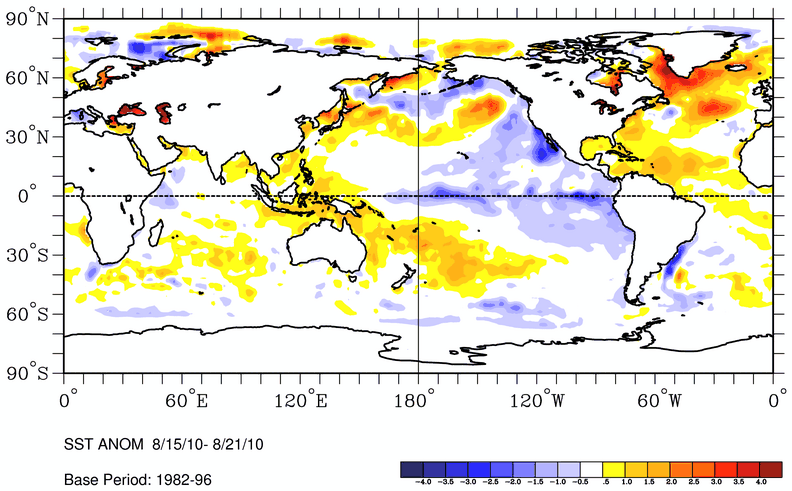
Sea-surface temperature anomalies around the world. Courtesy of NOAA ESRL. Click to enlarge.
———————————————-
Tomorrow we’ll talk about some of what causes tropical cyclones to move.
Permalink
« Previous entries Next Page » Next Page »













